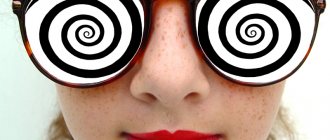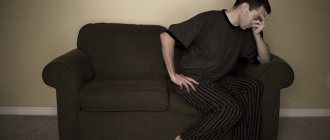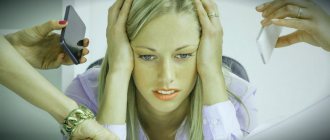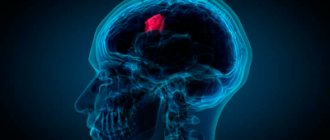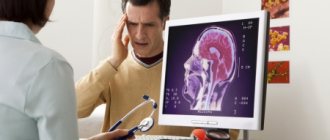Reactive psychoses
Taxonomy:
- affective-shock reactions (F0);
- reactive depression (F32 single episode, F0);
- reactive paranoid (F23,31);
- hysterical psychoses:
– puerilism; pseudodementia (F 44.80)
– hysterical twilight disorder (F 44.1 - 44.3)
- induced psychoses. Usually primitive individuals fall ill, and the inducer is an authoritative relative.
Treatment of reactive psychoses: psychopharmacological, psychotherapeutic.
Definition. The significance of personal characteristics in the occurrence of neuroses, the correspondence of neurosis and personality type. Other factors in the development of neuroses.
The role of the mechanism of conscious or unconscious fixation of the components of the conditioned reflex response; fear and other negative emotions as the cause of fixation. “Experimental neuroses” in animals as particular analogues of human neuroses. The presence of animals in which a “breakdown” cannot be caused by any influence.
Neurasthenia (asthenic neurosis, exhaustion neurosis). The main reasons are 1) disruption of work-rest cycles (overwork under conditions of necessary or forced emotional and volitional long-term obstacles); 2) asthenic personality type.
Polar types of neurasthenic neurosis:
– by origin: exhaustion neurosis – reactive neurasthenia;
– according to phenomenology: hyposthenic – hypersthenic.
Clinic. Basic symptoms (“irritable weakness”, lability) and additional:
- Autonomic lability due to excitement and the action of physiological factors;
- Hyperesthesia at the level of sensations (“sounds are deafening”, etc.), and emotional reactions, senesthopathy;
- Lability of needs: food, sexual, sleep;
- Lability of (other) mental processes: impatience, inability to wait (will); transient touchiness, dysphoria ↔ tearfulness (emotions), distractibility (will);
- At the personal level: hypochondriacal orientation, satiety with life and preoccupation with work, criticality and desire to recover.
Obsessive-compulsive neurosis as a general name for a group of neuroses. The multiplicity of psychogenic obsessions in all processes: obsessive memories, ideas (images), thoughts, concerns - fears, drives - desires, obsessive actions, etc.
Main features: psychasthenic personality; monomorphic; progression in the form of: (1) expanding the zone of reasons for actualizing a monomorphic symptom and (2) the emergence of protective actions (rituals). Features of rituals in neurosis are the lack of symbolism and psychological clarity.
Expanding zone of reasons: direct meeting with a stimulus (situation) → real expectation of meeting it → just a memory of a pathogenic stimulus. Tics - unlike rituals, initially these are acts that have an adaptive meaning, but later lose it (a person sniffs, shrugs).
Implications for general health
The causes of psychogenicity lie in psychological trauma of varying severity.
An individual’s experiences can be acute or chronic, characterized by a state of shock, depression or anxiety. In many ways, the course of the disease and the patient’s condition are determined by the severity of the injury and the degree of mental instability. A person who is sensitive by nature to emotional shocks experiences this condition much more difficult than someone whose psyche is more stable.
More often, psychogenic disorders occur in vulnerable and infantile people who react sharply to what is happening, as well as in people with mental retardation.
In addition, unfavorable life circumstances, the death of loved ones and long-term family troubles, a humiliating position of a person or awareness of physical deformity and inferiority can give impetus to the development of mental disorders. In this case, the disease develops slowly, gradually reducing vitality and leading the individual to a state of apathy.
It is not possible to find out how widespread such a disorder is, since many people do not assess their condition as painful, considering what is happening as a “everyday situation” and a “dark streak.”
However, it is safe to say that cases of the development of psychogenicity become significantly more frequent during mass upheavals in the form of wars and natural disasters.
Our psyche is sometimes unpredictable, and the same applies to prognoses for various disorders. The chances of recovery and possible consequences directly depend on the situation that caused the mental disorder, as well as on the individual characteristics of the body.
In addition, one should not miss such a moment as the timeliness of assistance - the earlier treatment is started, the higher the chance of a favorable outcome.
In some cases, the patient fully recovers from the shock, but it also happens that what happened leaves a mark for life.
In addition, psychogenic and reactive mental states can cause somatic diseases, for example:
- disruption of the gastrointestinal tract;
- problems with the respiratory system;
- heart and vascular diseases;
- enuresis and difficulty urinating;
- hormonal imbalances.
Also, as a result of mental disorders, frigidity occurs in women, and impotence in men.
Clinical forms (possible stages) of obsessional neurosis:
- Obsessive fears (phobias): agoraphobia, cardiophobia, etc. (F40);
- Obsessive thoughts (actual obsessions) and doubts (without significant fears with restrained actions) – F0;
- Obsessive actions (compulsive and rituals): for example, hand washing - F1;
- Panic attacks (episodic paroxysmal anxiety) – F0, similar to diencephalic crises (duration up to an hour, secondary neurotic layers in the form of an obsessive expectation of repetition, etc.).
Hysterical (conversion, dissociative) neurosis (“a chameleon that constantly changes colors” - Sydenham T.). Predisposition factors: hysterical (artistic) personality type, signs of mental infantilism, suggestibility. Psychological mechanisms: vivid imagination (idea of a possible disorder) → conversion (transformation of the physical into the mental) → fixation.
Symptom of relative benefit of a symptom (! - “relative” as opposed to simulation). Features of the behavior of patients: an egocentric attitude towards oneself and towards the disease with emotional logic, a sophisticated ability to attract attention (theatrics). Dependence of the accuracy of conversion “copying” on the accuracy of ideas about real disorders. Possibility of great depth of somatoneurological manifestations, comparable to those during hypnotization.
Symptoms of the disease
Physical manifestations include:
- periodic sharp pain in the heart area, which intensifies with physical activity;
- vegetative-vascular diseases;
- hypotonic syndrome;
- tremor of the limbs;
- increased sweating;
- dystonia;
- multifactorial anemia;
- lowering blood pressure.
A prolonged decrease in blood pressure greatly worsens the patient's condition. It leads to headaches and regular loss of consciousness.
The following manifestations are characteristic of neurosis:
- constant bad mood;
- irritation;
- touchiness and vulnerability;
- indecision;
- constant feeling of fear and anxiety;
- communication problems;
- fixation on negative situations;
- rapid onset of fatigue during physical labor;
- absent-mindedness and inability to concentrate;
- constant expectation of something bad;
- poor sleep;
- sensitivity to environmental changes;
- malnutrition or constant feeling of hunger;
- disorder of the vestibular apparatus;
- fainting and poor balance;
- stomach ache;
- fear of physical pain;
- sudden darkening of the eyes;
- decreased potency and sexual desire;
- cough for no reason;
- loose stools and constant urge to urinate.
They happen for no apparent reason. They are characterized by increased sweating on the palms, as well as difficulty and acceleration of breathing.
Additional symptoms of a panic attack:
- elevated temperature;
- chills;
- noise in ears;
- chest pain;
- fainting state;
- loss of orientation in space.
During a panic attack, the patient develops a fear of death, because he is afraid of suffocating or dying from cardiac arrest. To stop panic syndrome, sedatives are used because it is necessary to normalize the breathing rate.
Ways to restore breathing speed:
- wash the patient’s face with ice water;
- carry out breathing exercises;
- give ammonia a sniff if there is no hypersensitivity to it;
- Drink water periodically to restore your breathing rhythm.
Patients with neurosis experience the following problems during communication:
- slurred speech;
- redness on the face;
- increased sweating;
- stuttering;
- loss during circulation;
- nervous muteness;
- glossophobia.
Neurotic disorders are dynamic in nature: neurotic reactions, then neurotic states and then neurotic personality development. Neurotic reactions are short-term (no more than 1 month) disorders that include autonomic, sensorimotor, and affective manifestations in the absence of a struggle to restore social status.
They arise as a result of sudden exposure to psychological trauma (fright, unexpected notification of a loved one’s illness, betrayal, threat of punishment, etc.), and are more common in childhood and adolescence. The appearance of an assessment of one’s own illness and the behavior corresponding to it indicates a formed neurosis.
An increase in neurotic reactions for more than 6 months can lead to the development of a neurotic state. Neurotic personality development is formed during the chronic course of neurosis. At the same time, the structure of the personality is rebuilt, behavioral stereotypes that were previously unusual for the subject, and emotional reactions of a defensive nature appear - asthenic, hysterical, obsessive-phobic, psychasthenic, affectively excitable, hypochondriacal, subdepressive. General symptoms of neuroses:
- — well-being disorder: discomfort, headache, lethargy, weakness (especially after sleep), increased fatigue, rapid change from normal performance to loss of strength and “apathy,” unrefreshing sleep, unpleasant sensations in organs and parts of the body with functional disorders of their activity;
- emotional disorders: mood instability, sensitivity, impressionability, irritability; explosiveness, tendency to depressive reactions, fears and concerns, violent affective outbursts with emotional exhaustion, inadequate emotional reaction to the strength of the stimulus, lack of volitional control;
- disorders of mental functions: memory (forgetfulness, feeling of weakening of memorization and reproduction); attention (exhaustion, distractibility, or fixation on unpleasant sensations and memories); thinking (unpleasant obsessive thoughts of pessimistic content, affective thinking), sensations and perceptions (unpleasant tactile, painful and other sensations, weakening or loss of hearing, vision), consciousness (affectively narrowed consciousness);
- disorders of the effector-volitional sphere and drives: violation of sexual functions, appetite, self-preservation instinct, obsessive actions;
- somatovegetative and other disorders: increased sweating, hot flashes, increased dermographism, tachycardia, lability of pulse and blood pressure, diarrhea, constipation, fecal incontinence, nausea, regurgitation and vomiting, frequent urination and urinary incontinence, shortness of breath and difficulty breathing, functional paresis, paralysis , loss of speech, stuttering, tremors, tics.
Variety of disorders, their taxonomy:
- Autonomic (long-term disorders or paroxysmal - attacks similar to hypertensive crisis, etc.);
- Neurological disorders, sensory (hypoesthesia, blindness, etc.) and motor (paralysis, etc., tics, shudders, hysterical seizures);
- Mental (affective) behavioral disorders: “violent” reactions, emotional lability. The possibility of a combination of hysterical and depressive neuroses (the possibility of a persistent “depressive lining under hysterical neurosis and under a hysterical personality”).
Depressive neurosis (neurotic depression) – F 43.0. Predisposition factors: epileptoid personalities (hypersocial, rigid, uncompromising), partly (often) themselves creating psychotraumatic situations.
Features of neurotic depression: “hopes for a bright future”; “flight to work”; vegetative-dystonic masking disorders (hypotension, spastic colitis without clear hypochondrization); difficulty falling asleep, and when waking up - weakness and weakness without increasing melancholy; tearfulness-tearfulness (an indicator of low depth of depression).
The rarity of pure pictures of neuroses, diagnostic designation according to the predominant symptoms.
Neuroses with a predominance of vegetative-somatic or hypochondriacal disorders according to ICD-10 are classified as “somatoform disorders” (F 45).
The main symptom of all somatoform disorders is repeated, varied manifestations of somatic disorders, constant demands for medical examinations despite repeated negative examination results and doctors’ assurances about the absence of a physical basis for the symptoms. Moreover, even if physical disorders are present, they do not explain the nature and severity of the symptoms.
Differential diagnosis of neuroses from other diseases that manifest themselves at the beginning as neurosis-like syndromes (see Snezhnevsky’s circles).
Possible causes of the development of psychogenic impotence
The main step on the path to a complete cure is to identify the problem, that is, the provoking factor. Modern medicine distinguishes three decisive provocateurs that could influence the formation of the problem:
- psychological;
- personal;
- interpersonal.
The psychological factor goes deep with its roots in childhood. Most men, faced with psychological abuse in childhood, were taught by their parents the idea that sex is shameful, or scolded for any questions related to an intimate topic. In adulthood, a man simply remembers his parents’ instructions and is afraid of sexual intercourse; accordingly, the brain receives certain “lights out” signals and nothing happens.
The personal factor is often associated with depressive states and a man’s personal experiences. This may be the fear of not satisfying the partner, low self-esteem, as well as a feeling of guilt or debt to the partner.
The interpersonal factor consists of insufficient intimacy with a partner, mistrust, and quarrel.
Post-traumatic stress disorder
(F 43.1) – as a result of very severe stress; - a combination of neurotic, psychopathic and addictive symptoms. Psychology of persons with this disorder (refusal of medical care, etc.).
Treatment of neurotic disorders: voluntariness, sometimes duration, complexity. Components: psychotherapy, PFT (minor tranquilizers, mild antidepressants), restoratives, sanatorium treatment.
Psychotherapy is various forms of helping people who have difficulties. This assistance is carried out through communication, mainly through conversation, which leads to the elimination of both mental and somatic disorders and a deep understanding of the causes of these disorders and the behavior of the patient himself.
There are many classifications of psychotherapeutic methods depending on the different mechanisms of psychotherapeutic techniques. The most famous types of psychotherapy:
- Psychodynamic methods: orthodox psychoanalysis, neo-psychoanalytic directions of K. Jung, A. Adler and others, ego psychology, reconstructive psychotherapy, etc.
- Humanistic methods: existential, holistic, gestalt therapy, etc.
- Cognitive psychotherapy.
- Behavioral psychotherapy.
- Rational psychotherapy.
- Suggestive methods: classical hypnosis, Ericksonian hypnosis, self-hypnosis, autogenic training, etc.
- Body-oriented psychotherapy.
- Emotional-anal-rational therapy (Elisa).
- Cognitive behavioral therapy.
- Other methods: music therapy, play therapy, bibliotherapy, etc.
Symptoms of psychogenic impotence: features
Psychogenic impotence signs
is quite obvious, they can differ only in the intensity of their manifestation. The first symptom of the pathology is a weak erection. It can manifest itself in insufficient hardness of the penis during sexual intercourse, as well as in a decrease in the frequency of its occurrence.
If this pathology is not treated, it begins to acquire large proportions and the man’s erection completely disappears. Its complete absence can apply to both conscious moments (when sex is planned and stimulation has taken place) and spontaneous ones (when arousal occurs without the man’s “consent”).
Another symptom of the pathology is the inability of men to maintain an erection after it occurs. A similar sign may be rapid ejaculation or short-term sexual intercourse that does not end in orgasm due to the lack of penis hardness.
How to understand that mass malaise is caused by a psychogenic disease?
The following facts may indicate that a group of people may be affected by a mass psychogenic illness:
- Most people felt sick at the same time.
- Examination and tests did not reveal any pathologies.
- Doctors could not find any environmental factors (for example, poison in the air, water or food) that could cause such a reaction.
The general pattern of the outbreak (in particular, the type of illness, the nature of the spread, the specifics of the affected people) may also indicate a psychogenic illness.
At the same time, if you encounter the following symptoms, immediately consult a doctor to check for a real illness:
- The malaise continues for several days.
- You have a fever.
- You are experiencing muscle cramps.
- Tears are constantly coming from my eyes.
- It feels like there is a burn on the skin.



